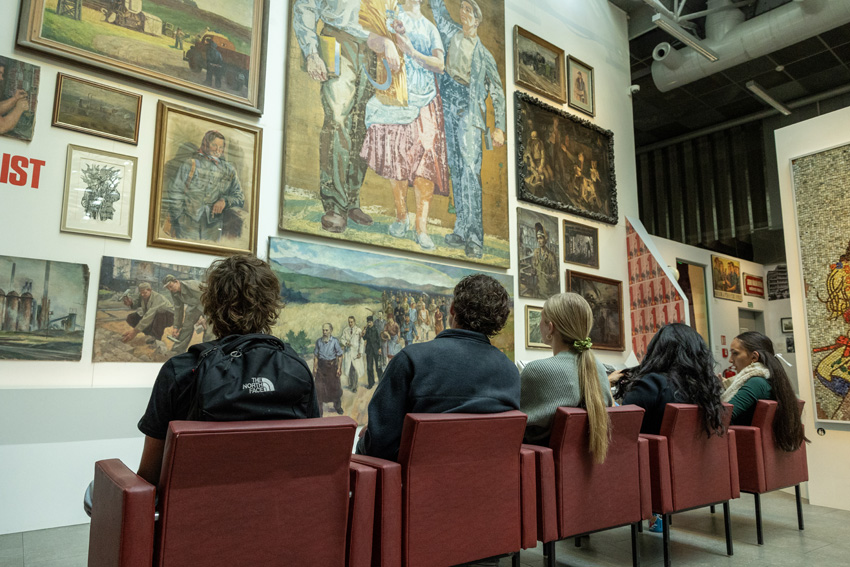Juniors Sara Peterson and Gabriela Siqueiros chose to interview Japanese internment survivor Diane Kanzaki-Reeves as part of their oral presentation after reading Jeanne Wakatsuki’s novel, Farewell to Manzanar. The following is part of Peterson’s and Siqueiros’ research and presentation of the Japanese internment after the bombing of Pearl Harbor. They relate Wakatsuki’s Manzanar experience to that of Reeves.
During World War II (WWII), war time hysteria affected many minority groups that resided in the United States. Anxiety increased tremendously in the west after the Japanese bombing of Pearl Harbor, Dec. 7, 1941. Many believed that any person with Japanese decent was in contact with the government overseas and conspiring against America.
In hopes of protecting the nation, president Franklin D. Roosevelt approved Executive Order 9066, Feb. 19, 1942. The act forced more than 127,000 Japanese American and immigrants in the west to government made internment camps.
Loyal and honorable Japanese Americans were angry and confused at the sudden hostility and fear everyone had towards them.
Diane Kanzaki Reeves, former internee, recalls the fear her parents felt when Executive order 9066 was enforced. When the govenrnment split up the Japanese Americans into camps, they commonly went by addresses.
“People were changing their names, in other states, to Chinese so that they would not be seen as Japanese,” Reeves said. “My grandmother told all her kids to come back closer to the house, for the addresses, so that we could stay together, otherwise we would have been all split up.”
Many Japanese internment camps were located in the California and Arizona deserts. Other camps were spread throughout the rest of the western United States.
For most, the ride from everything they had known was the hardest part due to their lack of knowledge on the camps, and what would await them there. Reeves recalls being shoved into the cattle cars with hundreds of others.
“We were told to go to this center, by alphabet, and everyone was given a number. We would be housed in the livestock stalls and then we rode on the cattle cars and they would take us to wherever camp they sent us to, but of course none of us had any idea where we were going to,” Reeves said. “Everyone was just shoved in a cattle car, just hundreds of people, and then you’re given numbers. I mean our family was together, but because of the alphabet, we were in the ‘T’ section, my grandparents were in the ‘H’ section and so on.”
Most Japanese-Americans would agree that the camps were incredibly degrading and unlawful, but some did not find the camps as bad. Although, they all agreed on one thing: the camps took away their freedom and broke their constitutional rights.
Every camp was in a different condition than the next. In most camps the Japanese-Americans were forced to live in very small barracks with many people in each one. Reeves clearly remembers her living quarters in the internment camps.
“In my living space it was only my parents and I but it was still very small,” Reeves said. “We could also hear all the other families through the walls because they were paper thin. We have any kitchen facilities or bathroom facilities, it was just a room. After every few barracks there would be a community bathroom that we would all have to share. ”
As time went on families were forced to adapt to their new way of living and make the best of their situation. Many used the term, “Shikata Ga Nai,” which means “it cannot be helped.” Reeves recollects the tight schedule they were put under.
“A typical day in the camp: a bell would ring in the morning for breakfast, then a second bell would ring for the kids to get their snacks, around mid day a bell would ring for lunch and then one for dinner,” Reeves said. “Those were the only set plans we had. Although many people didn’t have jobs, my dad was lucky and he was able to get a job in the mess hall. He made five dollars a month.”
Although most of the Japanese Americans imprisoned in the internment camps did not enjoy their time, Reeves and her family tried to make the best out of their experiences.
“There were sports in the camps, and my father was the captain of the baseball team,” Reeves said. “Their team was the best of all the blocks, they had a banner made, and they all signed their names on it. The banner went to the Smithsonian for a year, it went to four cities in Japan and it was shown in the California State Capitol Museum.”
To occupy their time in Tuke Lake CA, the internees would make art out of the scraps they found.
“Everything they made was recycled materials because we didn’t have anything. My dad would make a little drawer set for my hair ribbons and he made it out of recycled vegetables and fruit crates from the mess hall,” Reeves said. “They wove baskets and things out of the onion sacks and ties and different things. There were little shells on the river bottom, and the women would collect the shells and make corsages. They would make little flowers out of the shells.”
Farewell to Manzanar, by Jeanne Watasuki Houston, vividly describes her time spent in the internment camps. She recalls her living condition, the food served, latrines and emotional toll that living in the camps had on her family.
Houston also recognizes what her mother did for their family and the toll it took to stay strong for the sake of everyone else. The following is an excerpt from Houston’s novel Farewell to Manzanar.
“[Mama] would quickly subordinate her own desires to those of the family or the community, because she knew cooperation was the only way to survive. At the same time she placed a high premium on personal privacy, respected it in others and insisted upon it for herself. ? Almost everyone at Manzanar had inherited this pair of traits from the generations before them who had learned to live in a small, crowded country like Japan.?
Although their time in the camps were up, the hard times endured in the camps still had long term affects on Reeves and her family.
(PODCAST) Reeves recollects internment camp experiences: Feb. 6, 2014–
“We were released when I was about six years old, we went in alphabetical order so my grandparents went first and we went more towards the end,” Reeves said. “When we were released we had to start over from scratch, we didn’t have much money.”
Reeves currently lives in the same house her family lived in following their camp experiences.
For more related articles, read the 2013 Feb. 22 article, Kawashima recalls internment camp experience (VIDEO, PODCAST) or the 2012 May 18 article, Fibber recalls life in Arizona internment camp (VIDEO).
These writers can be reached via Twitter: @gaby_siqueiros @_sarapeterson. Follow The Feather via Twitter: @thefeather.
For more features, read the Feb. 5, FC increases technology use, involvement.






